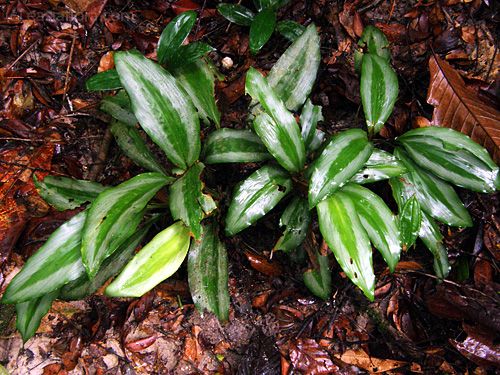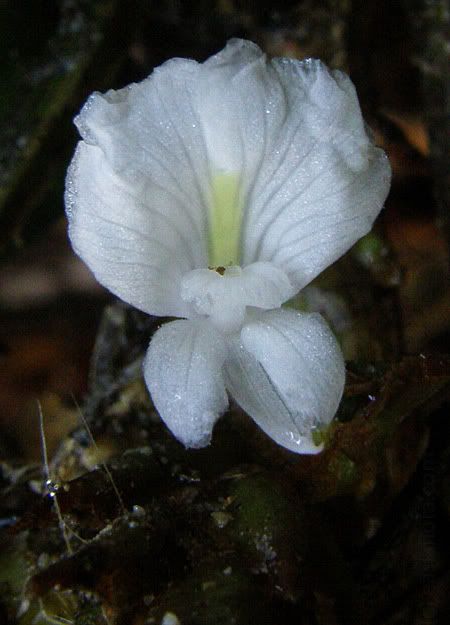
A couple of years or so back, this area was in international spotlight after sightings of creatures and giant footprints of what local officials claimed as "Big foot" or giant apeman. Some authorities even mooted the idea of declaring this a national park, but this soon fizzles off as palm oil prices skyrocketed. I had never seen these footprints, but I would very much love to have these claims proven true.
With this post, I end the Peat Forest series for now, until my next trip there....
Saturday, February 28, 2009
Unknown understorey plant
Thursday, February 26, 2009
Forest Rock Garden


Vertical
 Moss covered trunk and bracket fungus. Humidity is very high here, and the air is stale and still.
Moss covered trunk and bracket fungus. Humidity is very high here, and the air is stale and still.  Asplenium phyllitidis is another bird nest fern similar to A. nidus but has narrower leaves. It also inhibits lower and more humid place while A. nidus can be seen in open and dry places, including high up at roadside tree.
Asplenium phyllitidis is another bird nest fern similar to A. nidus but has narrower leaves. It also inhibits lower and more humid place while A. nidus can be seen in open and dry places, including high up at roadside tree.
Wednesday, February 25, 2009
A forest pepper
 This is the jungle version of our table pepper - Piper porphoryphyllum aff, is a humidity loving plant quite often seen in the Malaysian forest. It may be seen creeping along the undergrowth until it finds a good support from which it continue its growh upwards as shown. It is not an easy plant to grow in a normal garden although it is very ornamental. It will quickly succumb to even short periods of low humidity.
This is the jungle version of our table pepper - Piper porphoryphyllum aff, is a humidity loving plant quite often seen in the Malaysian forest. It may be seen creeping along the undergrowth until it finds a good support from which it continue its growh upwards as shown. It is not an easy plant to grow in a normal garden although it is very ornamental. It will quickly succumb to even short periods of low humidity.
Tuesday, February 24, 2009
Searching for violets
 Henckelia puncticulata is found only on steep banks around SE Johore area. Although locally common, globally it is very vulnerable to extinction as its habitat is not protected and subjected to haphazard and ill-planned developments. Where we found it, the plants are forming a vertical carpet covering a steep bank near the river. A bulldozer was noisily doing its damage just across the river as we took photos.
Henckelia puncticulata is found only on steep banks around SE Johore area. Although locally common, globally it is very vulnerable to extinction as its habitat is not protected and subjected to haphazard and ill-planned developments. Where we found it, the plants are forming a vertical carpet covering a steep bank near the river. A bulldozer was noisily doing its damage just across the river as we took photos.  This Asian relative of the African violet does look like its famous cousin, albeit with variegated leaves. I think it should have a place in horticulture.
This Asian relative of the African violet does look like its famous cousin, albeit with variegated leaves. I think it should have a place in horticulture. 
Monday, February 23, 2009
Bat Lily


This plant is available commercially as a kind of curio. Its not easy to grow at home since it likes dark damp habitat. Its cousin, T. chantrieri appears to be more accomodating and sets seeds easily too - in fact it self pollinates without external help.
Sunday, February 22, 2009
A variegated Scaphochlamys


More peat forest denizens

 A little moth baby (Lyssa menoetius *).
A little moth baby (Lyssa menoetius *).  I'm sure your parents will be so proud !
I'm sure your parents will be so proud !
Incidentally, this may be the first sighting of this moth in Peninsula Malaysia, although it has been reported in Borneo, Sangar (where ?) and Sulawesi as well as S. Thailand. More in this Moths of Borneo website.
* ID provided by Mr Gan from Nature Society, Singapore.
Saturday, February 21, 2009
Nepenthes gracilis
 Nepenthes gracilis is a widespread and common pitcher plant from SE Asia. Its latin name describes the long slender leaves characteristic of this species. The normal colour of the pitcher is green, sometimes spotted red but at this open shrubby grassland beside the peat forest, we saw a population with completely red pitchers,almost totally covered by club moss and dried leaves..
Nepenthes gracilis is a widespread and common pitcher plant from SE Asia. Its latin name describes the long slender leaves characteristic of this species. The normal colour of the pitcher is green, sometimes spotted red but at this open shrubby grassland beside the peat forest, we saw a population with completely red pitchers,almost totally covered by club moss and dried leaves..
While the pitchers are meant to catch prey, it is paradoxical that researchers had documented about 150 species of animals living within the pitchers (Phillips and Lamb 1996). These are commenals, that is they feed on excess food of the pitcher plants without doing any harm. Amongst these are frogs, tadpoles, insect larvae, crabs and crab spiders. Older pitchers are preferred since they are less acidic - so if you grow these plants, trim away the old pitchers to prevent mosquito breeding.
Friday, February 20, 2009
5mm
We all know babies are precious.... but this minute nymph sitting on the unripened pod of a Globba is a gem.
but this minute nymph sitting on the unripened pod of a Globba is a gem.
We were trekking in a threatened peat swamp forest in Johore, Peninsula Malaysia. The peat is formed in wet, seasonally waterlogged areas where decomposition of the organic matter was slowed due to low oxygen content, and hence lower bacterial activities. The whole area is rapidly cleared for oil palm plantation and we witness new devastations in every renewed visits. Fortunately, the plunge in international crude oil price right now should dampen the demand for so called "bio-fuel", which paradoxically, lay claims to be an environmentally-friendly substitute.
I am hoping the oil price will stay that way - it will certainly benefit both men and beasts, at least until greenhouse effect take over.
The next few posts will feature some flora and critters from this forest.
Saturday, February 14, 2009
L-O-V-E .... Begonia bataiensis

L is for the way you look at me
O is for the only one I see
V is very, very extraordinary
E is even more than anyone that you adore can ....
Nat King Cole is irreplaceable.
Begonia bataiensis is a dimunitive Vietnamese species from the karst outcrop, Ba Tai mountain, very recently described for the first time by Ruth Kiew in 2005. This is a treasured gift from a feverish collector.... : )
Looks like Picassa is having serious problem, switching to photobucket to rush out for this Valentine post.....
Saturday, February 7, 2009
The elusive Hoya obtusifolia

Supposedly, this is not a very common plant. My original specimen perished a couple of years ago and I am still looking for a replacement without success.
Friday, February 6, 2009
Dry
 Is this somewhere in Somalia ? Ethiopia ?
Is this somewhere in Somalia ? Ethiopia ?
.... Moon ?
Actually, its the surface of the great butress trunk of a Kapok tree Ceiba pentandra, tilted 90 degrees.
It has been almost two months without rain. This January is the dryest month in Singapore for the past 10 years. Only 38.3 mm of rainfall was recorded, a far cry from the long-term average of 244 mm.
